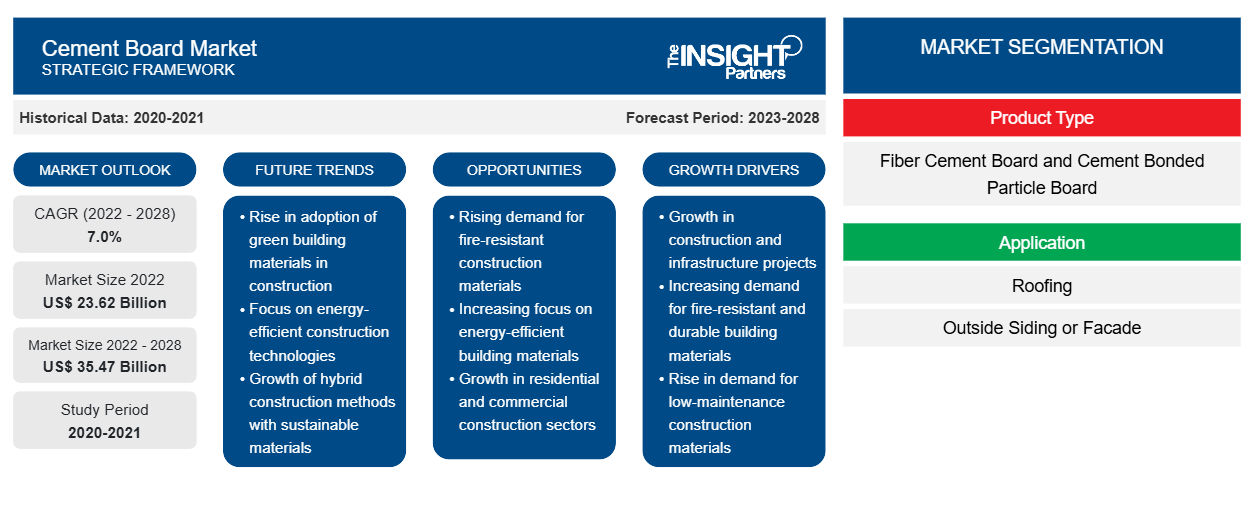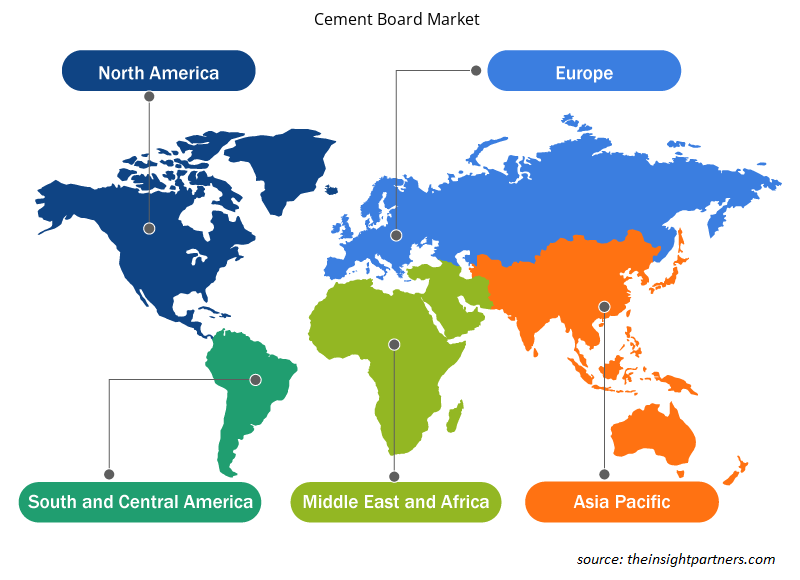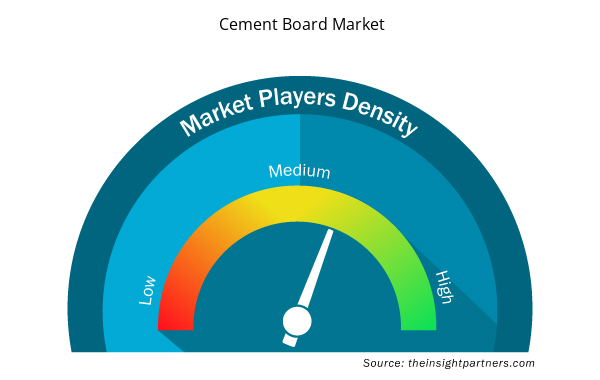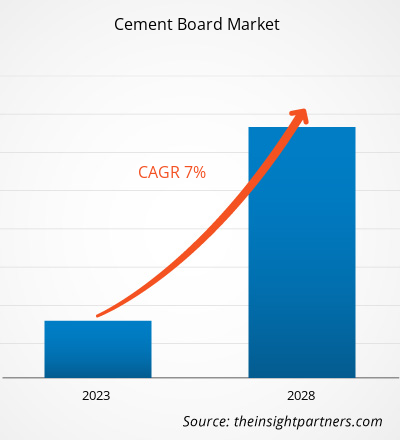[Research Report] The cement board market size is expected to grow from US$ 23,616.63 million in 2022 to US$ 35,473.56 million by 2028; it is estimated to record a CAGR of 7.0% from 2022 to 2028.
MARKET ANALYSIS
Cement board is a combination of cement, glass, aggregate, and fiber reinforcements that are formed into sheets and used as tile backing boards, and to build walls or floors. Cement board comprises of various product type such as fiber cement board and cement bonded particle board. Cement bonded particle boards have high stiffness, high fire resistance, high resistance to atmospheric agents and excellent acoustic insulation properties. They are largely used in flooring, facade, wall cladding, gates, and other construction products. Cement boards are used in various construction activities owing to its excellent physical characteristics such as non-combustible, water and UV resistance, resistance to rotting and wrapping, and others.
GROWTH DRIVERS AND CHALLENGES
Rising adoption of cement board in construction sector is boosting the global cement board market growth significantly. Durability is one of the most desirable qualities of cement board. Cement boards, and panels typically outlast vinyl siding and other alternative products in lifespan. Within 10 to 15 years, vinyl siding can show signs of aging, whereas cement board can last up to 30 to 50 years or more. Further, in cement production, carbon dioxide is a byproduct. However, manufacturing vinyl siding containing polyvinyl chloride (PVC) produces more carbon dioxide than cement production. Moreover, vinyl siding off-gases throughout its lifetime as it occupies a space landfill. Moreover, the upsurge in demand for energy-efficient buildings is further boosting the global cement board market growth. Modernizing cities in developing countries and increasing per capita income propel energy use in buildings across the world. High energy consumption in public, residential, and commercial buildings creates a need for energy savings. According to the International Energy Agency, buildings are expected to account for ∼41% of global energy savings potential by 2035, and the industrial sector and transport sector will hold 24% and 21%, respectively. A layer of cement board is applied to the building to reduce heat transfer through the walls, keeping the interior warmer in winter and cooler in summer, which makes a building energy efficient. However, the high cost associated with cement board purchase and installation, might limit its market growth.
Customize This Report To Suit Your Requirement
You will get customization on any report - free of charge - including parts of this report, or country-level analysis, Excel Data pack, as well as avail great offers and discounts for start-ups & universities
Cement Board Market: Strategic Insights

- Get Top Key Market Trends of this report.This FREE sample will include data analysis, ranging from market trends to estimates and forecasts.
Customize This Report To Suit Your Requirement
You will get customization on any report - free of charge - including parts of this report, or country-level analysis, Excel Data pack, as well as avail great offers and discounts for start-ups & universities
Cement Board Market: Strategic Insights

- Get Top Key Market Trends of this report.This FREE sample will include data analysis, ranging from market trends to estimates and forecasts.
REPORT SEGMENTATION AND SCOPE
The "Global Cement Board Market Analysis to 2030" is a specialized and in-depth study with a major focus on the global cement board market trends and growth opportunities. The report aims to provide an overview of the global cement board market with detailed market segmentation by product type, application, end-use, and geography. The global cement board market has been witnessing high growth over the recent past and is expected to continue this trend during the forecast period. The report provides key statistics on the consumption of cement board worldwide along with their demand in major regions and countries. In addition, the report provides the qualitative assessment of various factors affecting the cement board market performance in major regions and countries. The report also includes a comprehensive analysis of the leading players in the cement board market and their key strategic developments. Several analyses on the market dynamics are also included to help identify the key driving factors, market trends, and lucrative cement board market opportunities that would, in turn, aid in identifying the major revenue pockets.
Further, ecosystem analysis and Porter’s five forces analysis provide a 360-degree view of the global cement board market, which helps understand the entire supply chain and various factors affecting the market growth.
SEGMENTAL ANALYSIS
The global cement board market is segmented on the basis of product type, application, and end-use. Based on product type, the cement board market is segmented as, fiber cement board, and cement bonded particle boards. On the basis of application, the market is classified as, roofing, outside siding or façade, and others.
On the basis of end-use, the market is bifurcated into, residential, and non-residential. Based on product type, the fiber cement board segment accounted for a significant cement board market share which can be attributed to the rising adoption of cement board in the construction sector. Fiber cement board is a versatile and popular building material due to its durability and resistance to fire, moisture, and insects. Composed of cement, sand, cellulose fibers, and water, this board is commonly used for siding, roofing, flooring, and interior walls in residential and commercial construction projects. Fiber cement board is lightweight and easy to work with. Hence, it is preferred by builders and contractors. Based on application, outside siding or façade accounted for a major market. Fiber cement siding or façade can be used as an alternative to metal, traditional wood, and vinyl siding or façade. The siding or façade is available in various textures, colors, sizes, and shapes, allowing architects and builders to create unique and visually appealing designs. It offers key advantages such as durability and resistance to weathering, rot, mold, and pests. Based on end-use, residential segment accounted for significant share in the global cement board market. Demand for residential construction is propelling due to the increasing population. Fiber cement board and cement bonded particle boards are widely used in residential construction owing to their key advantages, including water resistance and termite prevention. In addition, rapid urbanization with an increasing expatriate population and growing demand for environment-friendly homes with a lower carbon footprint would augment the global cement board market growth for the residential segment during the forecast period. This will further attract new growth opportunities for the overall industry growth.
REGIONAL ANALYSIS
The report provides a detailed overview of the global cement board market with respect to five major regions, namely; North America, Europe, Asia-Pacific (APAC), Middle East and Africa (MEA) and South & Central America. Middle East & Africa accounted for a significant share of the market and valued at more than US$ 2 billion in 2022 and estimated to reach approximately US$ 3 billion in 2030. Rapid increase in construction activities, especially in Middle East, positively contributed to the market growth in Middle East & Africa. Asia Pacific is also expected to witness considerable growth valued at over US$ 8 billion in 2022, attributed to increasing demand of energy efficient buildings in the region is driving global cement board market growth. North America is also expected to witness considerable growth valued at over US$ 4 billion in 2022, attributed to the increased preference of fiber cement board over wood board is expected to boost the global cement board market growth.
INDUSTRY DEVELOPMENTS AND FUTURE OPPORTUNITIES
Partnership, acquisitions and new product launches were found to be the major strategies adopted by the players operating in the global cement board market.
- In Jan 2023, James Hardie Building Products announced a new distribution partnership with Boise Cascade Company.
- In Jan 2020, James Hardie Building Products showcased its HardieBacker Cement Board with HydroDefense Technology, at The International Surface Event (TISE) in Las Vegas.
Cement Board Market Regional Insights
Cement Board Market Regional Insights
The regional trends and factors influencing the Cement Board Market throughout the forecast period have been thoroughly explained by the analysts at Insight Partners. This section also discusses Cement Board Market segments and geography across North America, Europe, Asia Pacific, Middle East and Africa, and South and Central America.

- Get the Regional Specific Data for Cement Board Market
Cement Board Market Report Scope
| Report Attribute | Details |
|---|---|
| Market size in 2022 | US$ 23.62 Billion |
| Market Size by 2028 | US$ 35.47 Billion |
| Global CAGR (2022 - 2028) | 7.0% |
| Historical Data | 2020-2021 |
| Forecast period | 2023-2028 |
| Segments Covered |
By Product Type
|
| Regions and Countries Covered | North America
|
| Market leaders and key company profiles |
Cement Board Market Players Density: Understanding Its Impact on Business Dynamics
The Cement Board Market market is growing rapidly, driven by increasing end-user demand due to factors such as evolving consumer preferences, technological advancements, and greater awareness of the product's benefits. As demand rises, businesses are expanding their offerings, innovating to meet consumer needs, and capitalizing on emerging trends, which further fuels market growth.
Market players density refers to the distribution of firms or companies operating within a particular market or industry. It indicates how many competitors (market players) are present in a given market space relative to its size or total market value.
Major Companies operating in the Cement Board Market are:
- James Hardie Industries plc
- Plycem USA LLC
- Everest Industries Ltd
- Swisspearl Group AG
- Visaka Industries Ltd
Disclaimer: The companies listed above are not ranked in any particular order.

- Get the Cement Board Market top key players overview
IMPACT OF COVID/IMPACT OF GEOPOLITICAL SCENARIO/IMPACT OF RECESSION
The COVID-19 pandemic led to a decline in the progress of many industries across the globe. Shutdown of manufacturing plants and restricted trade across the globe led to supply chain constraints for the manufacturers across the globe. The COVID-19 pandemic adversely affected the growth of the chemicals & materials sector and the cement board market. The implementation of measures to combat the spread of SARS-CoV-2 negatively impacted the growth of various industries. Industries such as packaging, consumer goods, automotive & transportation, textiles, and building & construction were adversely affected by the sudden disruptions in operational efficiencies and value chains due to the sudden closure of national and international boundaries. During the COVID-19 pandemic, falling revenue and increasing project delivery challenges led to the sector’s contraction in most markets, with a corresponding negative impact on the labor force. Builders experienced delays and increased costs for imported raw materials and off-site building materials due to many factories being shut down for long periods. The damage to the building & construction industry hampered the demand for cement board. Therefore, the cement board market has recovered quite well from the aftermath of the pandemic and is expected to grow over the coming years.
COMPETITIVE LANDSCAPE AND KEY COMPANIES
Some of the key players operating in the cement board market include, include James Hardie Industries plc, Plycem USA LLC, Everest Industries Ltd, Swisspearl Group AG, Visaka Industries Ltd, Nichiha Corp, Soben International Ltd, SCG Building Materials Co., Ltd, Etex NV, and Compagnie de Saint Gobain SA among others.
- Historical Analysis (2 Years), Base Year, Forecast (7 Years) with CAGR
- PEST and SWOT Analysis
- Market Size Value / Volume - Global, Regional, Country
- Industry and Competitive Landscape
- Excel Dataset



Report Coverage
Revenue forecast, Company Analysis, Industry landscape, Growth factors, and Trends

Segment Covered
Product Type, Application, and End-Use

Regional Scope
North America, Europe, Asia Pacific, Middle East & Africa, South & Central America

Country Scope
Argentina, Australia, Brazil, Canada, China, France, Germany, India, Indonesia, Italy, Japan, Mexico, Russian Federation, Saudi Arabia, South Africa, South Korea, Turkey, United Arab Emirates, United Kingdom, United States
Frequently Asked Questions
According to the World Bank, across the world, a large proportion of the population lives in cities. In 2011, 52.0% lived in urban areas. Over the last ten years, owing to urbanization in developing economies in Asia and Oceania, the urban rate increased from 43.3% in 2011 to 50.0% in 2021. Africa has seen a 4.6% increase in the same period. Governments of various countries across the world focus on supporting and increasing construction activities. Saudi Arabia launched its Saudi Vision 2030 to diversify its economy, modernize its administration, and introduce bold reforms in many sectors. The country is targeting to increase the contribution of its construction sector to the overall GDP. Due to its Saudi Vision 2030, the country's construction market reports significant growth in residential and nonresidential segments and offers lucrative potential to cement board. Thus, to propel the construction and completion of affordable houses in rural and urban areas, the Government of India declared the allotment of US$ 6,107.0 crore to expedite the work on various stalled projects.
Durability is one of the most desirable qualities of cement board. Cement boards, and panels typically outlast vinyl siding and other alternative products in lifespan. Within 10 to 15 years, vinyl siding can show signs of aging, whereas cement board can last up to 30 to 50 years or more. Further, in cement production, carbon dioxide is a byproduct. However, manufacturing vinyl siding containing polyvinyl chloride (PVC) produces more carbon dioxide than cement production. Moreover, vinyl siding off-gases throughout its lifetime as it occupies a space landfill. Hence, cement board siding is a greener alternative to vinyl siding. Cement board products do not require frequent repainting as it holds paint well. Also, they do not dent unlike steel siding. Cement board products stand stronger in moisture and leaks than gypsum boards. These products possess excellent moisture-absorbing and drying properties, making them resistant to weather changes.
The major players operating in the global cement board market are James Hardie Industries plc, Plycem USA LLC, Everest Industries Ltd, Swisspearl Group AG, Visaka Industries Ltd, Nichiha Corp, Soben International Ltd, SCG Building Materials Co., Ltd, Etex NV, and Compagnie de Saint Gobain SA.
Based on the end-use, residential segment is projected to grow at the fastest CAGR over the forecast period. Demand for residential construction is propelling due to the increasing population. Fiber cement board and cement bonded particle boards are widely used in residential construction owing to their key advantages such as water resistance and termite prevention.
Asia Pacific accounted for the largest share of the global cement board market. Asia Pacific is one of the most significant regions for the cement board market owing to drastic increase in the number of construction and renovation activities.
Based on product type, fiber cement board segment held the largest revenue share. The growth of the segment is attributed to the excellent properties of the fiber cement board. Fiber cement board is a versatile and popular building material due to its durability and resistance to fire, moisture, and insects. Composed of cement, sand, cellulose fibers, and water, this board is commonly used for siding, roofing, flooring, and interior walls in residential and commercial construction projects.
Trends and growth analysis reports related to Chemicals and Materials : READ MORE..
The List of Companies - Cement Board Market
- James Hardie Industries plc
- Plycem USA LLC
- Everest Industries Ltd
- Swisspearl Group AG
- Visaka Industries Ltd
- Nichiha Corp
- Soben International Ltd
- SCG Building Materials Co. Ltd.
- Etex NV
- Compagnie de Saint Gobain SA

 Get Free Sample For
Get Free Sample For